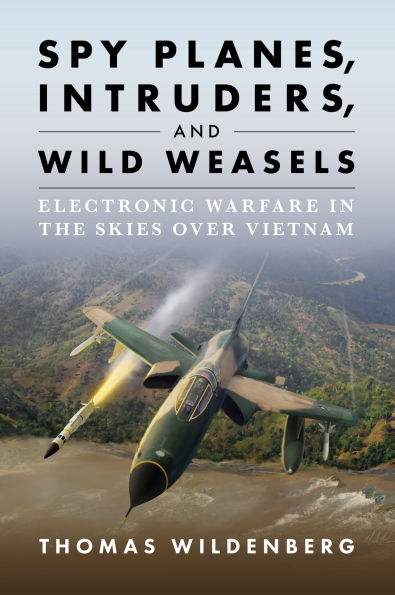The air war over Vietnam, often termed the first high-tech air war, was the first to feature electronic warfare (EW) in a decisive role. EW served not only as a means of defeating the surface-to-air missile—which was also used extensively for the first time during this conflict—but also as a way to improve the offensive and defensive capabilities of U.S. fighters in air combat. Spy Planes, Intruders, and Wild Weasels provides a comprehensive account of this heretofore neglected aspect of air combat history.
Thomas Wildenberg draws from a wealth of declassified CIA and NSA documents, as well as compelling accounts from veterans and technical experts, to describe the tactics, innovations, and impacts of electronic warfare in air combat in Vietnam. From the wide-scale use of airborne jamming to the creation of aircraft like the EA-6B, the first aircraft designed specifically for electronic warfare, this definitive work illustrates the importance of EW in the history of the Vietnam War and the development of modern electronic warfare. The author traces the impact of EW technologies through key phases of the war, including Rolling Thunder, Linebacker I, and Linebacker II. As the war progressed, so did the sophistication of electronic warfare techniques. It was the first conflict in which the suppression of enemy air defenses and the aircraft dedicated for this purpose, called Wild Weasels, became a major component of operational planning and use.
The book analyzes how U.S. forces adapted with advanced aircraft and equipment to counter North Vietnam’s increasingly sophisticated air defenses. Drawing from primary sources, the author offers a clear analysis of how electronic warfare changed military tactics, intelligence operations, and the future of conflict.
The air war over Vietnam, often termed the first high-tech air war, was the first to feature electronic warfare (EW) in a decisive role. EW served not only as a means of defeating the surface-to-air missile—which was also used extensively for the first time during this conflict—but also as a way to improve the offensive and defensive capabilities of U.S. fighters in air combat. Spy Planes, Intruders, and Wild Weasels provides a comprehensive account of this heretofore neglected aspect of air combat history.
Thomas Wildenberg draws from a wealth of declassified CIA and NSA documents, as well as compelling accounts from veterans and technical experts, to describe the tactics, innovations, and impacts of electronic warfare in air combat in Vietnam. From the wide-scale use of airborne jamming to the creation of aircraft like the EA-6B, the first aircraft designed specifically for electronic warfare, this definitive work illustrates the importance of EW in the history of the Vietnam War and the development of modern electronic warfare. The author traces the impact of EW technologies through key phases of the war, including Rolling Thunder, Linebacker I, and Linebacker II. As the war progressed, so did the sophistication of electronic warfare techniques. It was the first conflict in which the suppression of enemy air defenses and the aircraft dedicated for this purpose, called Wild Weasels, became a major component of operational planning and use.
The book analyzes how U.S. forces adapted with advanced aircraft and equipment to counter North Vietnam’s increasingly sophisticated air defenses. Drawing from primary sources, the author offers a clear analysis of how electronic warfare changed military tactics, intelligence operations, and the future of conflict.

Spy Planes, Intruders, and Wild Weasels: Electronic Warfare in the Skies over Vietnam
338
Spy Planes, Intruders, and Wild Weasels: Electronic Warfare in the Skies over Vietnam
338
Product Details
| ISBN-13: | 9781682476697 |
|---|---|
| Publisher: | Naval Institute Press |
| Publication date: | 10/28/2025 |
| Pages: | 338 |
| Product dimensions: | 6.00(w) x 9.00(h) x (d) |
